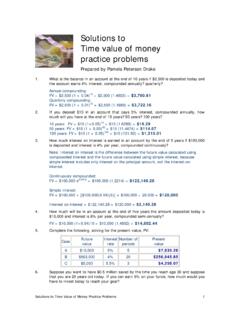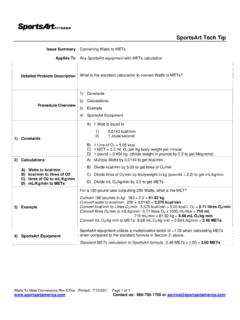Transcription of Expected Value in Project Management - intaver.com
1 Copyright Notice: Materials published by Intaver Institute Inc. may not be published elsewhere without prior written consent of Intaver Institute Inc. Requests for permission to reproduce published materials should state where and how the material will be used. Intaver Institute Inc. 303, 6707, Elbow Drive Calgary, AB, T2V0E5, Canada tel: +1(403)692-2252 fax: +1(403)259-4533 Expected Value in Project Management There are so many analytical techniques and tools, some of which are very complex and require a lot of effort to perform and others which are very industry specific. One of the very simple techniques is Expected Value analysis. This analysis is a choice engineering method, which means that it is more of a mental exercise rather than a strict and formal Project Management process. At the same time, going through the Expected Value thinking process may significantly improve quality of decisions.
2 How to win a lottery Questions regarding lotteries are pretty common fodder for us when people realize that our field touches on topics like risk and decision analysis. So, if I buy lottery tickets and I know that chances of winning are supposedly really small, am I just throwing away my money or is there some way to boost my chances? Needless to say, we are never short of advice, and it mostly follows these lines, You would most likely get a better return using other investment vehicles, like savings account or bonds. On the other hand lotteries can be really fun as long as winning is not part of your retirement planning. So if you want to have it as part of your entertainment budget, go ahead, knock yourself out. When really pressed, we may digress into more detailed discussion on Expected Value and whether anyone can justify playing the lottery, but by that point most of our audience will have moved on.
3 Let us assume that you bought 20 scratch-and-win lottery tickets. What would be the total return for all tickets if price for one ticket is $1? In other words, if you spent $20, how much should you expect in return? In fact, over the past several years, we have been conducting on ongoing experiment on this exact subject. When we have our presentations on risk and decision analysis, we buy $20 worth of scratch-and-win lottery tickets, which we give out at random to attendees. During the presentation, we have the attendees check their tickets. The results have been very consistent. After spending $20 for tickets, the payout has usually ranged from $7 - 12 dollars: we have never won more than we spent on the tickets. The theory behind this is very straight forward. Only a certain percentage from the ticket sales revenue goes toward prizes, normally around 50%. So the overall chance to win a lottery is around 50%.
4 The rest is used to pay costs for marketing and sales, but the vast majority of the owner s take is pure profit that usually gets funneled into public goods or charities, so we do not feel so badly about the extended losing streaks that are common for those who play the lottery, If it wasn t for the lottery, we would have to pay more taxes. Sort of like a bitter medicine with a tiny bit of honey. In this case, $ is the Expected Value of playing one game. So why would people play under such measly payout conditions? Quite simply really, there is a small chance to win a prize that is exponentially larger than the cost of the tickets. It is because of the potential for the large payout we would also argue that playing the lottery is a rational behavior. When discussing this with an acquaintance who participates in an office lottery pool, who also happens to be both a professional statistician and avid gambler, he said Of course I know all about odds, but somebody is winning!
5 Therefore, in each particular game, you may win more or less than the Expected Value . Risk takers hope that they will receive more than the Expected Value . Risk-averse people see the equation from the other side, and believe that the chances are that they will receive less than the Expected and therefore do not play. Expected Value is not the prize you expect to win. If there is a million dollar lottery, the Expected Value is not the prize. Rather, Expected Value is an indicator or a measure that will help you make better choices in uncertain situations. Expected Value is calculated by multiplying each possible outcome by its probability of occurrence and then summing the results. Expected Value can be calculated based on any parameters that are possible to measure such as cost, price, duration, or number of units. Situations when we can use simple Expected Value calculations arise all the time.
6 When you buy a couch in furniture store for $1000, the salesman will probably offer you damage insurance for around $50. Without insurance, let s estimate that it would cost you on $200 to repair any damage. In addition, the chance that your couch will be damaged such that it will require a repair is 10%. In this scenario, the Expected Value of a repair is $200 x 10% = $20, which is significantly less than insurance cost. Therefore, unless you have five boys who like to bounce up and down on your couch with swords, forks and scissors, you should probably pass on the insurance. Expected Value will help you decide on a course of action in more complex cases. For example, lawyers us Expected Value when they make recommendations to their clients regarding possible legal actions. Would it be better to take a plea bargain and plead guilty to lesser charges or face the chance that you might lose at trial?
7 Oil companies use Expected Value to calculate the volumes of oil and gas they can produce given uncertainties in petroleum reserves. Sales managers can use Expected Value to estimate sale figures. Governments are supposed to use Expected Value to estimate potential tax revenue. Since most governments are pathologically in debt, whether they understand the concept is open to question, or perhaps they just use an unrealistic probabilities (100%) when performing Expected Value analysis on revenues. For Project managers Expected Value is a simple and very effective analytical technique that can help us reduce the effect of many Project illusions. It is a mostly simple mental exercise, and is is part of the Project Management process described in PMBOK Guide, Chapter 11 ( Project Management Institute 2009). How much will the Project cost given the chance of delay? Since there is always a chance that a supplier may not be able to deliver components on time, which supplier should you choose?
8 Let s return to our discussion on lotteries. If your idea of winning is getting more money out than you put in, than our recommended strategy is Don t do it. However, if you find that you cannot help yourself, here we have another suggestion. Pick an number that appears to be non-random ( 1,2,3,4,5, ..). It will not increase your chances of winning, but if you win, you will be less likely to share the prize with someone else. Why? Most people think that these numbers are not random enough and don t select patterns. In reality, 1,2,3,4,5 is as random as any other combination of numbers. How Project managers ignore Expected Value The advantage of Expected Value is that you do not need to perform any complex calculations. You simply multiply probabilities on possible outcomes for different scenarios and then compare the results. Even though it is simple, people do not bother to do these calculations even though substantial sums may be at risk.
9 In 2005, an administrative law judge Roy L. Pearson filed a civil case in the District of Columbia. He claimed that a dry-cleaning company had lost his trousers. Over a period of time, the owners of the dry-cleaning business made three settlement offers of $3000, $4600, and $12000 respectively, all of which were rejected by Pearson. Claiming the shop s satisfaction guaranteed sign misled customers; Pearson sought $1,500 for every day the dry-cleaning operation was in business over a four year period of time or $54 million. Needless to say, the case generated a significant amount of attention and ridicule. Fortune magazine listed the case at #37 in its "101 Dumbest Moments in Business" of 2007 (Fortune 2007). Eventually, after years of working its way through the legal system, a federal court rejected Pearson s appeal (Alexander 2009). Pearson must be a real risk taker.
10 What was the chance that he would be successful in getting $54 million for a lost pair of pants? We imagine that he was probably angling for a lavish settlement rather than public humiliation. One can always make the case that the Pearson did perform an Expected Value analysis, it is just that his assumptions must have been horribly skewed, so perhaps he is now working for the government providing tax revenue forecasts. In any event, Pearson s poor decision regarding the Expected Value of his legal actions, only managed to increase the misery of not only himself, but the unfortunate owner of the dry cleaning business. As it turned out, the pants in question were never really lost, the dry cleaners had merely misplaced them temporarily. While it may surprise some of our leaders, union leaders often have a good understanding of the underlying business situation facing their employers and use this knowledge to negotiate realistic compensation packages.






